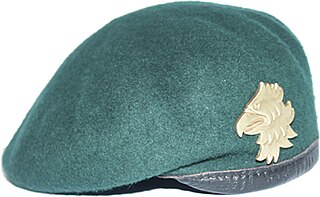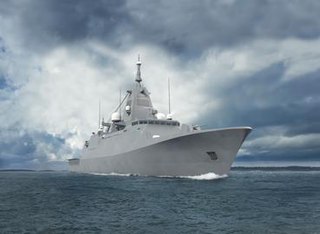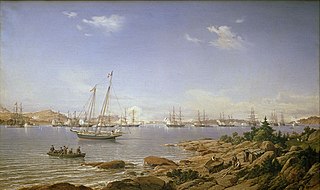
The Finnish Defence Forces (FDF) (Finnish: Puolustusvoimat, Swedish: Försvarsmakten) are the military of Finland. The Finnish Defence Forces consist of the Finnish Army, the Finnish Navy, and the Finnish Air Force. In wartime, the Finnish Border Guard becomes part of the Finnish Defence Forces.

The Finnish Navy is one of the branches of the Finnish Defence Forces. The navy employs 2,300 people and about 4,300 conscripts are trained each year. Finnish Navy vessels are given the ship prefix "FNS", short for "Finnish Navy ship", but this is not used in Finnish-language contexts. The Finnish Navy also includes coastal forces and coastal artillery.

The Uisko class, also known as the Marine Alutech Watercat M11 landing craft is a type of vessel in use by the Finnish Navy. It is the predecessor of the Jurmo class landing craft. Uisko was the first water jet vessel of the Finnish Navy. It features excellent maneuverability and low draft suitable for shallow waters. It can be used for amphibious assault and transport of marine infantry. The uisko has a cargo capacity of 2.5 tons.

The Baltic Fleet is the fleet of the Russian Navy in the Baltic Sea.

The Hamina-class missile boat is a class of fast attack craft of the Finnish Navy. They are classified as "missile fast attack craft" or ohjusvene, literally "missile boat" in Finnish. The Hamina FACs are based at Upinniemi, and form the 7th Surface Warfare Squadron, part of the Finnish Coastal Fleet, together with the minelayers MLC Hämeenmaa, Porkkala and Pyhäranta.

The Baltic Sea campaigns were conducted by Axis and Allied naval forces in the Baltic Sea, the Gulf of Bothnia, the Gulf of Finland and the connected lakes Ladoga and Onega on the Eastern Front of World War II. After early fighting between Polish and German forces, the main combatants were the Kriegsmarine and the Soviet Navy, with Finland supporting the Germans until 1944 and the Soviets thereafter. The Swedish Navy and merchant fleet played important roles, and the British Royal Navy planned Operation Catherine for control of the Baltic Sea and its exit choke point into the North Sea.

The Estonian Navy are the unified naval forces among the Estonian Defence Forces.

HNoMS Olav Tryggvason was a minelayer that was built by the naval shipyard at Horten in the early 1930s with the yard number 119. She served in the Royal Norwegian Navy until captured by the Germans in 1940. The Germans renamed her first Albatros II, and a few days later Brummer. She was wrecked in a British bombing raid in northern Germany in April 1945.
Archipelago Sea Naval Command was a Finnish Navy unit headquartered in Pansio, Turku. Its main operating area was the Archipelago Sea. Archipelago Sea Naval Command was formed in 1998 by combining the Archipelago Sea Fleet and Turku Coastal Regiment. The command was wound down at the end of 2014 and its constituent units were moved to a new command, the Coastal Fleet, which contains all vessels of the Navy.

Katanpää-class mine countermeasure vessels are a class of three multipurpose mine countermeasure vessels (MCMV) ordered by the Finnish Navy. The nearly 250 million euro contract was awarded to the Italian shipyard Intermarine S.p.A. in 2006. Initially, all three vessels were scheduled to be delivered by 2014 and the class was expected to achieve operational readiness by 2015, but there have been various delays and the last vessel was handed over to the Finnish Navy in November 2016.

Gulf of Finland Naval Command was a Finnish Navy unit headquartered in Upinniemi, Kirkkonummi.

The Finnish Coastal Jaegers or Finnish Marine Commandos are the marines special operations capable forces unit of the Finnish Navy. The unit consists of both regulars and conscripts, predominantly Swedish-speaking, and is located at Nyland Brigade in Dragsvik, near Ekenäs.

The Polish Navy is the naval branch of the Polish Armed Forces. The Polish Navy consists of 46 ships and about 12,000 commissioned and enlisted personnel. The traditional ship prefix in the Polish Navy is ORP.

Jehu-class landing craft are a class of military transport vessels used by the Finnish Navy. Manufactured by Marine Alutech under the designation Watercat M18 AMC, the boats can perform a multitude of tasks ranging from troop transport and landing operations to patrolling and escort tasks as well as combat and battle support operations. The Jehu-class boats are considerably larger and better armed that the preceding Jurmo-class landing craft.

The Pohjanmaa class is a series of four multi-role corvettes currently under construction for the Finnish Navy as part of the Squadron 2020 project. Together with the existing four Hamina-class missile boats, the four new surface combatants will form the backbone of the Finnish Navy from the mid-2020s onwards. They will replace seven older vessels that have been or are due to be decommissioned; the minelayer Pohjanmaa, two Hämeenmaa-class minelayers and four Rauma-class missile boats.

The Åland War was the operations of a Anglo-French naval force against military and civilian facilities on the coast of the Grand Duchy of Finland in 1854–1856, during the Crimean War between the Russian Empire and the allied France and Britain. The war is named after the Battle of Bomarsund in Åland. Although the name of the war refers to Åland, skirmishes were also fought in other coastal towns of Finland in the Gulf of Bothnia and the Gulf of Finland.

Pyhäranta is a Finnish Pansio-class minelayer that was commissioned in 1992. The ship underwent an extensive mid-life refit in 2017, but ran aground and damaged its hull during an exercise in August 2022. At that time, it was based at Upinniemi and was a part of the 7th Surface Warfare Squadron of the Finnish Coastal Fleet along with the other minelayers Hämeenmaa and Porkkala, as well as several Hamina-class fast attack craft.

















